 |
|||||
|
|||||
| Preview of Stamps Catalogue: VOLUME 1 |
 |
|||||
|
|||||
| Preview of Stamps Catalogue: VOLUME 1 |
Return To Catalogue - Nova Scotia 1860 issues - Canada
Note: on my website many of the
pictures can not be seen! They are of course present in the catalogue;
contact me if you want to purchase it.
Nova Scotia issued its own stamps from 1851 until 1867. Now a province of Canada. I have tried to describe the forgeries as accurate as possible, but some questions remain unanswered about some of them, especially concerning the Oneglia forgeries of the 1860 issue.
1 Penny brown
Value of the stamps |
|||
vc = very common c = common * = not so common ** = uncommon |
*** = very uncommon R = rare RR = very rare RRR = extremely rare |
||
| Value | Unused | Used | Remarks |
| 1 p | RRR | RR | 120 stamps per sheet, 600,000 stamps were send to Nova Scotia |
| Reprint | R? | ||
The paper of the originals is bluish, the reprints have white paper (made in 1890). They were made in 1890 on the authority of Mr.Haggert, the Postmaster General of Canada (5 sheets were printed).
Four different kinds of forgeries exist. Forgers that made forgeries of the 1 p stamp are Spiro, Moens, Fournier and another forger (most likely this would have beenOneglia or Panelli). Most of them seem to have had difficulties in correctly reproducing the head of the Queen. Moens made a black and white reproduction and the Spiro forgery seems to be very crude. Source: 'Nova Scotia Fakes & Forgeries' by Captain R.B.Mitchell
Example of a Fournier forgery:


The above stamps are said to be Fournier forgeries, the head of the Queen is quite different compared to a genuine stamp. They often bear strange cancels, such as "CORREOS 7.1.60. II-III" in a circle, but other cancels exist. They are not included in his 1914 pricelist and also do not appear in 'The Fournier album of philatelic forgeries'. Note the position of the corners of the square surrounding the Queen's head compared to the genuine stamp. This forgery is also described in Album Weeds (the only forgery given in this book).

(Spiro forgery?)
I think the above stamp is a Spiro forgery (but I'm not 100% sure, image obtained from Richard Frajola, who thinks this is a Fournier forgery).
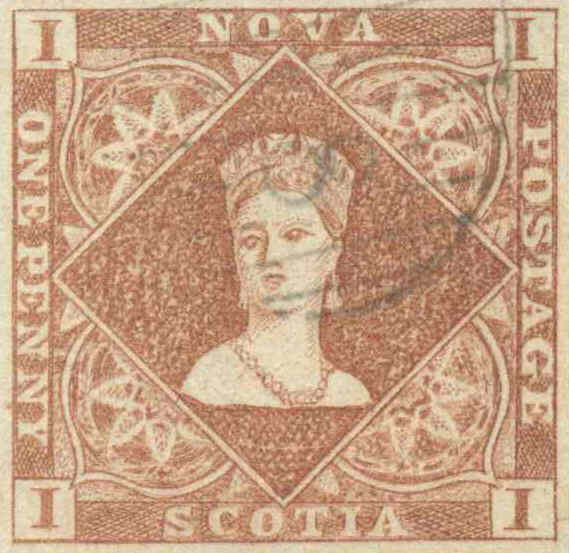

(Oneglia/Panelli forgery, image
obtained from Richard Frajola, I've also seen it with very wide
margins)
The above forgery has the face very strange. There are other differences in, for example, the lettering. It is sometimes attributed to either Oneglia or Panelli. It has a forged numeral '8' cancel of New Brunswick(!).

(Moens? forgery, colour black)
3 Pence blue 6 Pence green 1 Shilling violet
Value of the stamps |
|||
vc = very common c = common * = not so common ** = uncommon |
*** = very uncommon R = rare RR = very rare RRR = extremely rare |
||
| Value | Unused | Used | Remarks |
| 3 p | RR | R | 160 stamps per sheet |
| 6 p | RRR | RR | 160 stamps per sheet |
| 1 Sh | RRR | RRR | 160 stamps per sheet, with sheet watermark 'T.H.Saunders'. |
| Reprints | R? | Probably 5 sheets were printed of each value | |
The most common cancel appears to be an ellipse filled with
horizontal lines. Other cancels are a large numeral, for example
a red '10' or a black '3' or '5'. Also a British style 'A91',
'A93', 'A95', 'A97' and 'A98' exist (these are mailboat cancels).
More info:
http://www.frmfoundation.org/NovaScotia/period2/images/ns0205.pdf.
I've seen a bisected 3 p stamp, together with two 3 p stamps (together 7 1/2 p) on an envelope to Scotland. This was apparently authorized by the postmaster Woodgate in October 1854 and the only authorized bisection (however, other bisects were accepted but not official, see http://www.frmfoundation.org/NovaScotia/period2/images/ns0201.pdf). I've also seen a bisected 3 p stamp, together with a 6 p stamp on a letter to England.
These stamps were also cut into 4 pieces on letters (3 p as 3/4 p, 6 p as 1 1/2 p). Forgeries exist of these quartered bisects (for example Raoul de Thuin made forgeries on letter with a non-existing cancel 'CREPUSFUND' see 'The Yucatan Affair, The work of Raoul Ch. de Thuin, Philatelic Counterfeiter', published by The American Philatelic Society).

Most likely a Raoul de Thuin forgery. The 'Wood Islands' cancel
and the '6' is known to have been forged by him as well as the
elliptic line cancel. Probably the whole envelope was doctered by
him.



Three forged De Thuin covers with bisected stamps, all with a
forged 'HALIFAX NOVA SCOTIA' cancel. The cancel is not really
circular, also in the genuine cancel, there is a dot between
'NOVA' and 'SCOTIA' according to the Yucatan Affair book.
Reprints exist of all 3 values (made in 1890).
The paper of the originals is bluish, the reprints have white paper, the colours are slightly different. They were made in 1890 on the authority of Mr.Haggert, the Postmaster General of Canada (5 sheets of each value according to: http://www.frmfoundation.org/NovaScotia/period2/images/ns0204.pdf).
Spiro forgeries:





(reduced sizes)


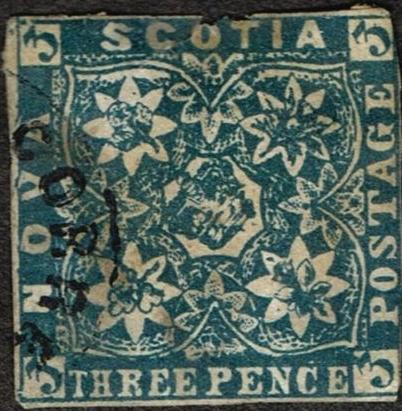

Primitive 3 p forgery, note the squeezed "H" of
"THREE" and the fact that the "P" of
"PENCE" is placed too far to the left (such that it is
right under the center of the ornament above it). Also note the
"CORREOS" cancel on some of the above forgeries.
The above stamps are Spiro forgeries. They can easily be identified by their strange cancels in general. There are 2 types of the 3 p forgery: in the first type the crown touches the octogonal around it, in type 2 it doesn't. Francois Fournier offers 3 p and 6 p forgeries in his 1914 pricelist, I presume he is offering the Spiro forgeries. Spiro also seems to have made forgeries of the 1 Sh, but I don't have a picture of this forgery. The 6 p has small lines in the word "SIX PENCE" as in the genuine, however, these lines are missing in the word "POSTAGE" (described as second and third forgery of the 6 p in Album Weeds, in the third forgery the '6's in the corners touch the containing rectangle).
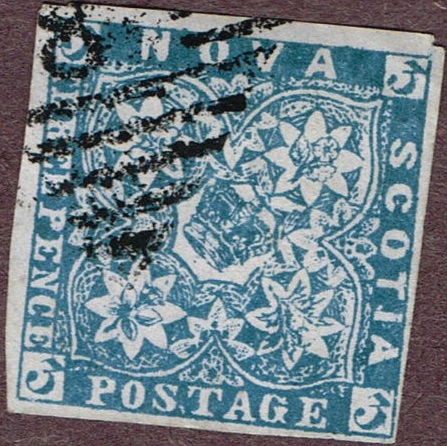
Here a 3 p forgery with a "8"
numeral cancel that also exists on many forgeries of other
countries.
Oneglia forgeries (images thanks to Richard Frajola):
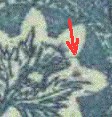
(Characteristic line of the Oneglia forgeries)
I suspect the above stamps to be Oneglia
forgeries. They are engraved as the genuine stamps (and therefore
more difficult to detect). There is a distinct line that can only
be found in these forgeries (see picture above). In the 6 p the
two lines inside the "X" of "SIX" are not
broken (in the genuine stamps one of these lines is interrupted).
These forgeries are mostly cancelled with the shown grid with an
'8' in it (at the right side), but other cancels exist (according
to 'Nova Scotia Fakes & Forgeries' by R.B.Mitchell): a circle
of diameter 25 mm containing 10 , 13 or 14 horizontal bars or a
"N35" cancel. These forgeries often have very large
margins and the engraving is very heavy.
According to the journal BNA Topics (May, 1972 page 116), in an
article called 'The Panellis' by E.A.Smythies, the forged grid
"8" cancel has two unbroken lines besides the
"8", while the genuine cancel only has one such line.
The genuine cancel '8' belongs to Chatham New Brunswick, it was
also applied by Oneglia/Panelli on forgeries of Nova Scotia and
Newfoundland.
Unknown forger:
A 3 p forgery in the wrong colour (according to 'Nova Scotia Fakes & Forgeries' by Captain R.B.Mitchell there should be another forgery of the 3 p in the wrong colour):

In this forgery the flower to the left of the crown is completely different.



(Images obtained thanks to Richard Frajola)
I've been told that the above forgeries are Fournier forgeries. They look too primitive to have been actually produced by Fournier, they were probably just sold by him and made by someone else. As in the last forgery, the flower to the left of the crown has been replaced by something completely different (a nut?). I've seen them with several bogus cancels "1575", "6080", "Lagaude"(?). Note that in the 1 Sh there are '1's in the corners (there should be '12's). It seems that many colours exist besides the ones shown here, for example I have seen: 1 Sh green (see http://members.tripod.com/claghorn1p/NovaScotia/NS06x.htm), this serie is therefore also called 'Rainbow series' and 1 Sh yellow:

('Rainbow forgery' 1 Sh yellow, reduced size)

Rainbow forgery; 3 p yellow.
A Moens forgery of the 6 p value in the wrong colour:

(Moens forgery)
I've been told that the next forgery is a so-called Sanderson forgery. I have no further information:

(Sanderson forgery, image obtained from Richard Frajola)
Album Weeds mentions another dangerous forgery of the 6 p, where the lines inside the "X" of "SIX" have the opposite breaks with respect to the genuine stamps. The unbroken line should go from the left bottom to the right top. In this forgery the unbroken line goes from the right bottom to the left top.
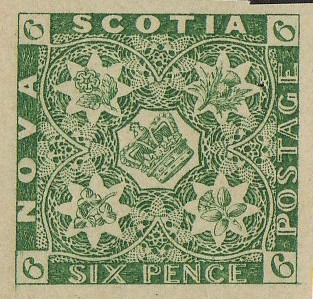
I've also seen the 12 p and 3 p value of this particular forgery.

"FACSIMILE" overprint on a 3 p blue forgery
The above forgery is often referred to as forgery made by forger 'A' (the identity of this forger is unknown'. The name 'forger A' was suggested by Nicholas Argenti in his book 'The Postage Stamps of New Brunswick and Nova Scotia'. Often these forgeries have an overprint 'FAC-SIMILE'. These forgeries are engraved. The width of the stamp is nearly 24 mm (instead of 23 mm).

I've been told that these forgeries of New Brunswick have been
made by the same forger 'A' as the above three forgery


These might have been produced from this printing plate with New
Brunswick and Nova Scotia stamps side by side in two blocks of
four as they are now in the possesion of the Canadian Museum of
History after having been discovered in a flee market in Belgium
in 2013. Last picture in mirror-image. See also:
https://www.cbc.ca/news/canada/ottawa/hidden-treasures-canadian-museum-of-history-1.4752740
The next forgeries might have been made by the same forger:

(Image obtained from Richard Frajola, the "6"s in the
corners are different from the genuine stamps)

Cut from the 'Souvenir sheet' as shown below

(London Exhibition Sheet)
In 1950 a souvenir sheet was issued in London for 'The London International Stamp Exhibtion'; On this souvenir sheet there is a 1 Sh Nova Scotia 1852 violet stamp, a Penny Black, a New South Wales 1 p red 1850, a Ceylon 4 p 1859 and a 4 p Cape triangle of 1853, it was reproduced by the collotype process and printed by Waterlow & Sons. The Nova Scotia 1 Sh stamp exists cut out from this sheet and pasted on a 18th century letter. Furthermore I have seen all the cuts from this sheet offered as forgeries.
Bisected stamps should be looked upon with the greatest precaution (many forgeries exist). They exist bisected or even divided into 4 (the 3 p used as 3/4 p, the 6 p as 1 1/2 p).
Click here for the issues of Nova Scotia of 1860.